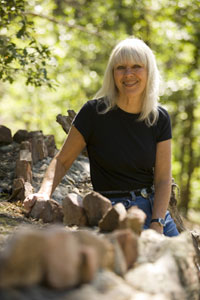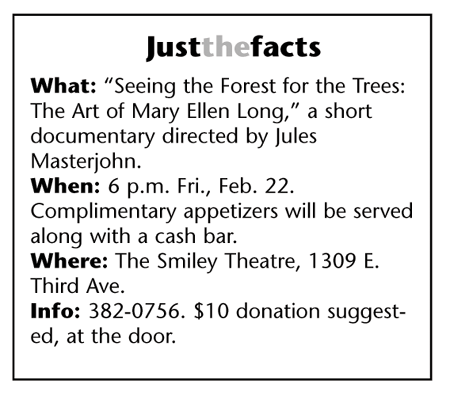| ||||||
A leaf, a stone, a pinecone
by Judith Reynolds Like Mary Ellen Long’s art itself, a new film about her work takes a subtle path. “Seeing the Forest for the Trees: The Art of Mary Ellen Long” is about wonder, discovery and the alchemy of creation. The documentary is a mere 23 minutes in length, so don’t expect a biopic. What it offers is an inside look at an environmental artist whose collaborations in the woodland are often so quiet, so discreet you cannot tell where nature begins and the human hand intervenes. Director Jules Masterjohn and Cinematographer Christopher Hall have taken their cues from the best possible source – Long herself. The filmmakers plunge us directly into the present, at the peak of a highly successful artistic career. Only occasionally do brief flashbacks fill in bits of back-story. For example, we learn almost obliquely about a California childhood and Western maturity. The script is informal in that we learn about the artist from her own voice. In one of the most telling moments, Long reveals a simple incident that triggered her relatively late commitment to a life in art. “One time, a piece of paper flew out into the forest and landed on a twig,” Long remembers. “That was the beginning of doing art in nature. It made a connection for me.” She was in her 30s, she tells us, not exactly the legendary child prodigy or adolescent burning with artistic passion. How refreshing. Like a vivid pebble shimmering in a mountain stream, Long’s candor illuminates the entire film. Whether sitting on a rock in dappled forest light or in her studio, Long sets a quiet, contemplative tone. No emotional torment here, no clichéd revolt, no unresolved childhood crises, just a powerful love of nature and a mature willingness to look at life and death through nature’s twin lens of time and decay. The film opens in darkness, a black screen. With the barest hint of wind chimes, the movie introduces us to the sound of a forest world. Next, we see Long somewhere in a wood walking in a circle. Through dry leaves, she ambles around and around, picking up pinecones. To the uninitiated, Long might seem lost. But we soon learn she’s exploring a bower as if it were a maze to be studied. And we suspect she’s beginning a new work, a fresh collaboration with nature. In a spare voice over, she offers us her aesthetic philosophy: “Art should be powerful … to reach the viewer it has to have content.”
Through dry leaves, she ambles around and around, picking up pinecones. To the uninitiated, Long might seem lost. But we soon learn she’s exploring a bower as if it were a maze to be studied. And we suspect she’s beginning a new work, a fresh collaboration with nature. In a spare voice over, she offers us her aesthetic philosophy: “Art should be powerful … to reach the viewer it has to have content.” And then the film quietly steps into the various ways her mature works evoke the content of her art: “spirit of place.” It’s the trees, leaves, lichen and worm larvae of Long’s works that recreate her experience of place. Although we see a number of pieces from her long career, it is the outdoor works at Edgemont Highlands, where Long is artist in residence, that get the most attention. Over the last three years Long has created more than 30 environmental sites along the trail system in the Highlands. In the film, Long walks some of those trails and points out delicate or formidable interactions. Not to be missed are human-sized shard towers created from the clay-pipe detritus of old water courses. In a section about the smallest of Long’s works, a series she calls Nature Bundles and what I see as “sketches,” the camera slowly pans these tiny combinations. The bundles unite objects in unusual ways. The objects come from seashore and forest, a twig and a shell, porcupine quills and wooden burl. In this section, the subtlety of John Pennington’s musical score is most effective. He has created a musical strand combining the colors of violin, percussion and guitar. Those strands quietly underscore a slow pan of Long’s bundles pinned to a black background. The section on artist’s books will be illuminating for those as yet uninitiated into this contemporary art form. Long talks about the intimacy of the book as an object to be held, how she prepares papers or whole books by burying them over the winter, and how they come to resemble earth sculpture or ancient artifacts. Credit Masterjohn and Hall for artfully weaving together spectacular images and the spoken word – and for avoiding the talking head syndrome altogether. Long is never photographed center screen. Instead, she’s found sitting in the forest, in her studio or by a lake. The filmmakers also incorporate still photographs with seamless ease, scanning over some early black-and-white photos of the artist as a child and young woman, merging them effortlessly with current settings and images. The film is nonlinear but has a distinct, if subtle, structure. Wisely, the filmmakers have steered clear of Long’s personal life, which happens to contain a long and loving marriage, family, children and grandchildren. The film does not address Long’s enormous commercial success as a collage artist. The focus is entirely on Long as an environmental artist, and it’s a poetic tribute to an extraordinary talent among us. •
|
In this week's issue...
- May 15, 2025
- End of the trail
Despite tariff pause, Colorado bike company can’t hang on through supply chain chaos
- May 8, 2025
- Shared pain
Dismal trend highlights need to cut usage in Upper Basin, too
- April 24, 2025
- A tale of two bills
Nuclear gets all the hype, but optimizing infrastructure will have bigger impact




